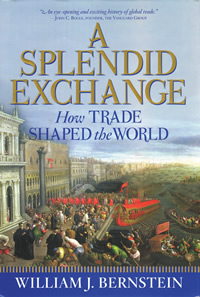By William J. Bernstein
Atlantic Monthly Press
494 pages
The amount of trade conducted across national borders throughout the world is astounding. According to the International Monetary Fund, more than $20 trillion of goods and services will be exchanged among nations this year.

The United States alone will import or export over $4.5 trillion of goods and services in 2008—it trades with virtually every country. Yes, Americans import wine from France and chocolate from Belgium, but they also enjoy diamonds from Botswana, fish from the Faroe Islands and jewelry from Oman. U.S. exports include computer accessories to Niue, shingles to Rwanda, and meat and poultry to Azerbaijan.
Such is the world of trade. People sometimes argue about whether so much trade is good, but mostly they take it for granted. It is rare to hear someone say, "Imagine; this cinnamon came all the way from Sri Lanka" or "I wish I could find Minnesota coffee beans."
And yet the trade that is commonplace today reflects the fruits of a grand, sometimes tragic history of human endeavor, a history of risk-taking and inspired ingenuity. Trade brought small countries to world prominence, stimulated technological innovation and built international dynasties. This is the story told by William J. Bernstein in A Splendid Exchange.
A history of world trade might sound like a book targeted to insomniacs and diehard history buffs. That would be the case had Bernstein written a chronological tome of world trade from 3000 B.C. to today. But while he covers a prodigious amount of time and space, his volume is not a reference book. Instead, Bernstein believes "the history of trade is best told through carefully selected stories and ideas." And Bernstein is a gifted storyteller.
His essential message is that the "urge to trade has profoundly affected the trajectory of human species." Two themes run throughout his storytelling: One is the human determination and ingenuity for trading; the other is how trade contributed to the rise and fall of empires.
Human ingenuity
From civilization's earliest days in the Middle East's Fertile Crescent, the desire for trade has spurred resourcefulness. Trading began for the purpose of covering basic needs: grain to eat, stone for buildings and metals for tools and weapons. The first traders faced the most fundamental problem—how to get stuff from here to there. Bernstein describes evidence of the earliest "boats": large floating barges made from animal skins wrapped around a wood or antler frame that could be guided downriver. These barges carried the goods and a few donkeys. Why donkeys? The boats couldn't travel upstream; the donkeys were for the return journey, when they carried home the "imports," plus the valuable animal skins.
Shallow waters, pirates and adverse winds made the Red Sea a poor option for transporting incense from modern day Yemen to Egypt and the Mediterranean. So traders turned to the land and used camels. Strange as this may sound, Bernstein provides an absorbing (pun intended) discussion of camels—the differences between the dromedary and Bactrian varieties (one hump or two) and a biological explanation for a camel's ability to go days without water. (No, it does not store water in its hump(s).)
The desire for more long-range trade drove improvements in ship design and nautical ability. Overland routes to transport silk from China to the Mediterranean—the Silk Road—were brutal and difficult. Travel by boat was no luxury, but shipping times were greatly reduced as mariners learned how to use seasonal monsoon winds to cross the Arabian Sea.
The huge rewards to early mariners from trade pushed them to great nautical accomplishments or to their death, and often both. Bernstein tells the fascinating stories of three 15th and 16th century explorers: Vasco da Gama's remarkable 28,000 mile round-trip journey from Europe to India around the southern tip of Africa; Christopher Columbus' inept attempt to reach the Spice Islands by sailing west—"like many single-minded men, Columbus deluded himself at almost every turn"; and Ferdinand Magellan's successful attempt to reach the Spice Islands from the west by swinging around South America (and discovering the Magellan Straits). These now-famous explorers are the success stories; many ships left harbor never to be seen again.
A string of inventions in the 19th and early 20th centuries resulted in traded goods being readily available and inexpensive throughout much of the world. Bernstein describes, for example, the impact of Henry Bessemer's process for making cheap, high-quality steel for railroads, the steam engine and shipping. Between 1830 and 1910, the costs of shipping by sea and land fell by 65 percent and 87 percent, respectively.
But human ingenuity is only part of Bernstein's story of trade.
Trade and empires
Throughout A Splendid Exchange, Bernstein also highlights the dramatic impact trade has had in shaping empires. A constant theme is the important role of "choke points" in shipping trade, an issue that remains today in the Persian Gulf and other shipping lanes. The defeat of Athens by Sparta in 404 B.C. provides an early example. Spartan control of the Hellespont, now known as the Dardanelles, allowed the Spartans to block critical grain shipments to the Athenians, who were then starved into submission.
The Roman Empire established Pax Romana, a stable period that allowed long-range trade to flourish. After its decline, desert Arabs from the Middle East took up the mantle and created a new era of world trade referred to as Pax Islamica. Bernstein argues that the rapid expansion of Islam from Spain to India was promulgated by trade. For centuries, Muslim traders dominated commerce in the Red Sea, the Persian Gulf and throughout the Indian Ocean.
That domination evoked Portuguese and Spanish responses. Looking for a route to the riches of India and the Spice Islands that wasn't controlled by Muslim traders, da Gama circled Africa in the late 15th century, and his voyage marked the beginning of Portuguese control of Spice Island trade. Bernstein's discussion makes clear the brutality with which Portugal built and maintained its grip.
With the same goal but a different direction, the Spanish circled to the west, leading eventually to the settlement of the Caribbean and the Americas. Bernstein's account of the development of Barbados and other Caribbean islands is a gruesome tale of slave plantations, and his discussion of the trading triangle between the New World, England and Africa is both fascinating and horrifying. Over 9.5 million African slaves arrived in the New World. The majority were sent to Brazil and the Caribbean; 5 percent landed in the United States and Canada.
The Dutch, with their advanced political, legal and financial institutions, built the first world trading system. The privately owned Dutch East India Company developed new strategies for financing trade, including the opportunity for private investors to diversify their risk. Trade ventures were sold to willing risk-takers, who could purchase 1/32 or 1/16 shares in a variety of ships, so that if any one ship did not make it, the profits of the others would provide sufficient compensation.
Of course, not all looked favorably upon trade. Antitrade sentiment rose in England as cheap exports, especially of cotton, poured into the country. In response, a British lawyer and essayist, Henry Martyn, made the case for free trade in a pamphlet titled "Considerations upon the East India Trade" (published in 1701, 75 years before Adam Smith), arguing that "if the East-Indies wou'd send us Cloaths for nothing, as good or equivalent of those made in England by prodigious labour of the People, we shou'd be very ill imploy'd to refuse the Gift." Martyn's arguments didn't defeat the antitrade movement, however; perhaps he was too far ahead of his time.
In another case with major historical ramifications, Bernstein tells of a group of wealthy smugglers and merchants who objected to a large decline in protective tariffs that would have undercut their profits (but greatly benefited consumers). These protectionists boarded ships tied up in a harbor and dumped crates of foreign imports into the ocean. Perhaps, like me, you recall a different version of the Boston Tea Party from your grade school days—something about taxation without representation. But a quick check of other sources validates the general thrust of Bernstein's account.
Shortcomings
I suspect that serious historians will object to some of Bernstein's broad and selective brush strokes across 5,000 years of world history. But I think he can be forgiven on this account. This is not intended to be a scholastic work on trade history, but is instead a collection of historical stories about the development of the world through the activity of trade. On that score, I think the book succeeds nicely.
My main criticism of A Splendid Exchange lies with its final chapter, where Bernstein turns from providing historical tales to rendering his economic analysis of modern day trade issues. Though he clearly understands the theory of comparative advantage—he gives an excellent description—he fails to apply its lessons to himself. His advantage lies in his ability to turn his passion for historical research into a compelling book. But his analysis of current economic issues is selective at best, and often confused or just wrong.
For example, Bernstein argues that "highly paid factory jobs are disappearing overseas and being replaced with burger-flipping slots" and that job insecurity has grown dramatically in recent decades. There is considerable evidence against both claims. For example, the effects of outsourcing on employment and earnings have been found to be relatively small, and many—though not all—researchers find a positive overall impact. Furthermore, several economists have documented a decline in job insecurity over recent decades.
Bernstein's discussion of inequality is also problematic. He looks at the distribution of family income over time without realizing that family structure has changed dramatically over the past 35 years. And he mystically intuits that the "sweet spot" for social welfare schemes lies somewhere between the programs in Northern Europe and the United States.
Near the end of the book, Bernstein argues that had America closed its borders to all trade in 1945, it would have "almost certainly retained a larger slice of the world's wealth," even though the world's wealth would have been smaller. Such a claim runs counter to historical evidence; slamming the door to world trade would have surely resulted in the steady demise of the U.S. economy, and while the world's wealth might have temporarily paused, it surely would have continued to grow.
Nonetheless, the passion, insight and eloquence that Bernstein brings to the historical story of trade more than offset the shortcomings of his economic analysis. And for the reader, there is an easy remedy: Read the first 13 chapters and skip the final one. Or skim it with a skeptical eye.
More careful economic analysis of trade and globalization is available elsewhere. The Region has provided or reviewed some excellent resources. The 2003 Annual Report essay by Nobel Laureate Robert Lucas is an outstanding discussion of economic development, including the role of trade. I also recommend the fine book Why Globalization Works by Martin Wolf (reviewed in September 2006) for a thorough discussion of research related to modern trade.
Plough the deep
A Splendid Exchange is a welcome step back from the often heated debate about globalization and trade. Its epic tales of human ingenuity and determination are inspirational.While Adam Smith seems to have received all the glory as the original advocate of free trade, the largely forgotten Henry Martyn made a cogent case well before Smith was even born, an argument that rings as true and poetic today as when he wrote it over 300 years ago:
Why are we surrounded by the Sea? Surely that our Wants at home might be supply'd by our navigation into other Countries, the least and the easiest Labour. By this we taste the spices of Arabia, yet we never feel the scorching Sun which brings them forth; we shine in silks which our Hands have never wrought; we drink of Vinyards which we never planted; the Treasures of those Mines are ours, in which we have never digg'd; we only plough the Deep and reap the Harvest of every Country in the World.





